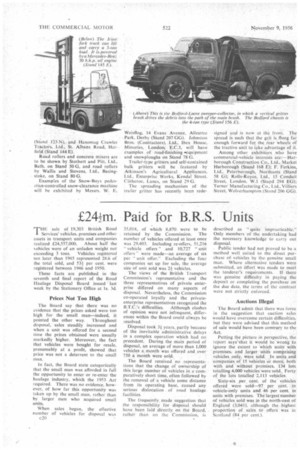£24-0. Paid for B.R.S. Units T HE sale of 19,303 British
Page 58

Page 59

If you've noticed an error in this article please click here to report it so we can fix it.
Road Services' vehicles, premises and other assets in transport units and companies
realized £24,557,000. About half the vehicles were of an unladen weight not exceeding 3 tons. Vehicles registered not later than 1945 represented 28.6 of the total sold, and 53+ per cent. were registered between 1946 and 1950.
These facts are published in the seventh and final report of the Road Haulage Disposal Board issued last week by the Stationery Office at Is.
Prices Not Too High
The Board say that there was no evidence that the prices asked were too high for the small man—indeed, it pointed the other way. Throughout disposal, sales steadily increased and when a unit was offered for a second time the prices obtained were usually markedly higher. Moreover, the fact that vehicles were bought for resale, presumably at a profit, showed that price was not a deterrent to the small man.
In fact, the Board state categorically that the small man was afforded in full the opportunity to enter or re-enter the haulage industry, which the 1953 Act required. There was no evidence, however, of how far this opportunity was taken up by the small man, rather than by larger men who acquired small units.
When sales began, the effective number of vehicles for disposal was c20 35.018, of which 8,870 were to be retained by the Commission. The number of vehicles offered at least once was 29,403. Including re-offers, 51,216 " vehicle offers" and 10,727 " unit offers " were made—an average of six per " unit offer." Excluding the four companies set up for sale, the average size of unit sold was 23 vehicles.
The views of the British Transport Commission's representative and the three representatives of private enterprise differed on many aspects of disposal. Nevertheless, the Commission co-operated loyally and the privateenterprise representatives recognized the B.T.C.'s difficulties. Although clashes of opinion were not infrequent, differences within the Board could always be resolved.
Disposal took 3i years. partly because of the inevitable administrative delays in a complex operation which had no precedent. During the main period of disposal, an average of more than 1,000 vehicles a month was offered and over 750 a month were sold.
The Board received no representations that the change of ownership of this large number of vehicles in acomparatively short time, often followed by the removal of a vehicle some distance from its operating base, caused any serious dislocation of road haulage facilities.
The frequently made suggestion that the responsibility for disposal should have been laid directly on the Board, rather than on the Commission, is described as quite impracticable." Only members of the undertaking had the necessary knowledge to carry out disposal.
. Public tender had not proved to be a method well suited to the direct purchase ofvehicles by the genuine small man. Where alternative tenders were submitted, an &Tort was made to meet the tenderer's requirements. If there was genuine difficulty in paying the deposit or completing the purchase on the due dale, the terms of the contract were not strictly enforced.
Auctions Illegal
The Board admit that there was force in the suggestion that auction sales would have overcome certain difficulties, but they were advised that this method of sale would have been contrary to the Act.
Putting the picture in perspective, the report says \that it would be wrong to ignore the extent to which units with premises, and larger units comPrising vehicles only, were sold. In units and companies of 15 vehicles or more, both with and without premises, 134 lots totalling 4.000 vehicles were sold._ Forty of the lots totalled 2,113 vehicles, Sixty-six per cent, of the vehicles offered were sold-97 per cent.. in vehicle-only units and 46 per cent, in units with premises. The largest number of vehicles sold was in the north-east of England (3,041), although the highest proportion of sales to offers was in Scotland (84 per cent.).
ESTABLISHED in 1796, John Harvey and Sons, Ltd., Bristol, wine shippers and merchants, make balanced use of ancillary chides and the facilities of British Road .ervices and private hauliers. The company's Lead offices are in Denmark Street, Bristol, and here are branches at London, Cardiff, Kidderainster, Chatham, Portsmouth, Manchester. Volverhampton. Portland and Devonport. „ondon, Kidderminster and Portsmouth oranches are the largest.
Lt Bristol. These Ill 1 ude two Leyland :ornets, a Dennis
LrtieuIated unit, a lennis 6-ton van, two =loirtrrier 30-cwt. vans, m Austin 25-cwt. van. i Morris 10-cwt. van ind a Hillman estate .4r.
Vehicles based at .the branches arc )f smaller capacity. In London there k re an Austin 25-cwt. and an Austin 10-cwt. van, both under contract but :arrying Harvey's name. At Kidderninster there are an Austin Countrynal], a Morris 20-cwt. model and a Flames 10-cwt. van. Portsmouth )ranch has an Austin 25-cwt. van and 1. Morris i0-cwt. van under contract. 3evonport branch uses a Morris 10-cwt. van and an Austin Countryman, whilst Manchester has a Commer 30-cwt. van. Mere is an Austin 25-cwt. van at Cardiff, and Morris utilities at Portland and Chatham, also an Austin Countryman used by a representative at Harrogate.
Harvey's transport department also :ontrols over 40 directors' and repreientatives' cars. In addition to that :onveyed by the company's own transport. a large arriount of goods is carried by the general haulage services of B.R.S. and private hauliers.
As all wines are imported, the first road task is moving the produce from Bristol or London docks, and from




























































































































